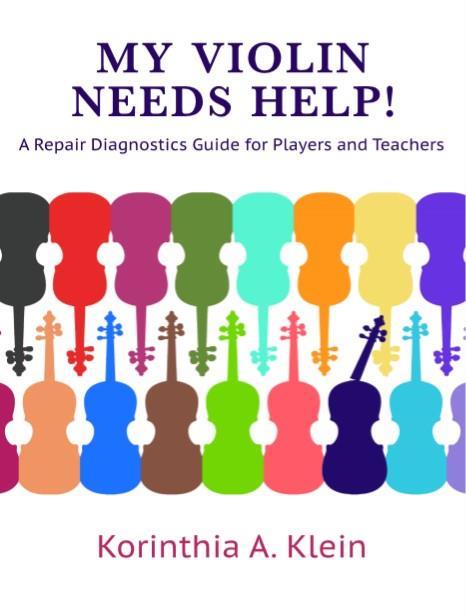Celia Cobb reviews a manual that explains the basics of violin maintenance to the layperson

My Violin Needs Help!: A repair diagnostics guide for players and teachers
Korinthia A. Klein
134PP ISBN 9781733388955
Korinthian Violins $15
This short book is a goldmine of useful and interesting information. It is aimed at teachers and players who would like to know more about their instruments but perhaps lack the confidence to make decisions about when to sort out small problems for themselves, and when to leave well alone. The author, a luthier based in the US, draws on her experiences as a teacher, learner and player, as well as a violin maker and repairer, and her aim is to help violinists (and other string players) to understand problems that may occur with their instruments, and to know what to do next.
The book gives a thorough inventory of the parts of the instrument and their associated potential pitfalls, as well as comprehensive information about the bow. There are short chapters on glue and varnish, as well as a useful section aimed at teachers running string programmes; speaking as someone who has a violin-graveyard-style cupboard filled with a motley collection of bows and instruments in varying states of health and decay, I found this section particularly helpful. Cellos are not left out – they have their own chapter, including information about wolf notes and how to hunt them, and endpins and how to wrangle them.
The text is written in a friendly, chatty style which manages to be informative, entertaining and easy to understand without being patronising, and there are many useful black and white photographs, clearly labelled where necessary. There is plenty of niche information, which is always useful to impress your fact-hungry students. Did you know, for example, that the horsehair in a bow is usually taken from horses living in places with cold climates, like Mongolia or Siberia, because the animals’ hair is thick and less likely to have been damaged by swatting flies in the heat? Or that the alternating light brown and black stripes seen on some bows should be referred to as ‘faux whalebone wrap’, as it mimics the old bow making tradition of using baleen (whalebone) wrapping?
Throughout the book, the focus is on identifying and understanding problems, and deciding on the next course of action. The author shares her knowledge about simple fixes, highlights problems that need a luthier, and also addresses the issue of student instruments, such as when to spend money on repairs and when it would be more cost-effective to simply replace them: ‘If the stick on a student bow has snapped – it’s done. You can use it as a tomato stake.’
If you want information about all things violin, such as how to prevent bow bugs, when to change your strings and whether it is ever fine to use glue on an instrument, then this is the book for you. Perhaps more importantly, if you ever encounter a problem with an instrument and need to decide what steps to take, this practical resource will very likely have the answer for you. And although that answer will probably be ‘take it to a luthier’ – these words feature many times throughout the text, for very good reason – reading this book will educate and entertain you in equal amounts as you work it out.
CELIA COBB



































1 Readers' comment